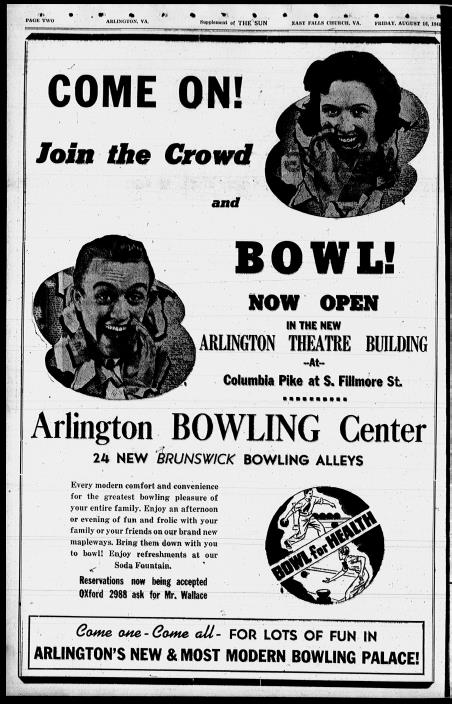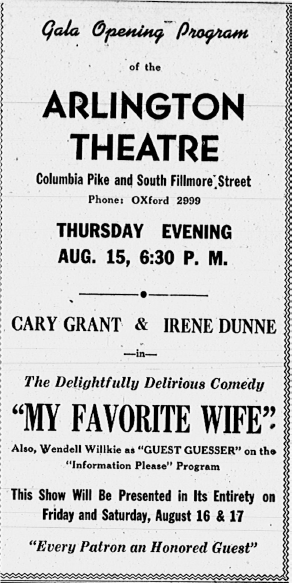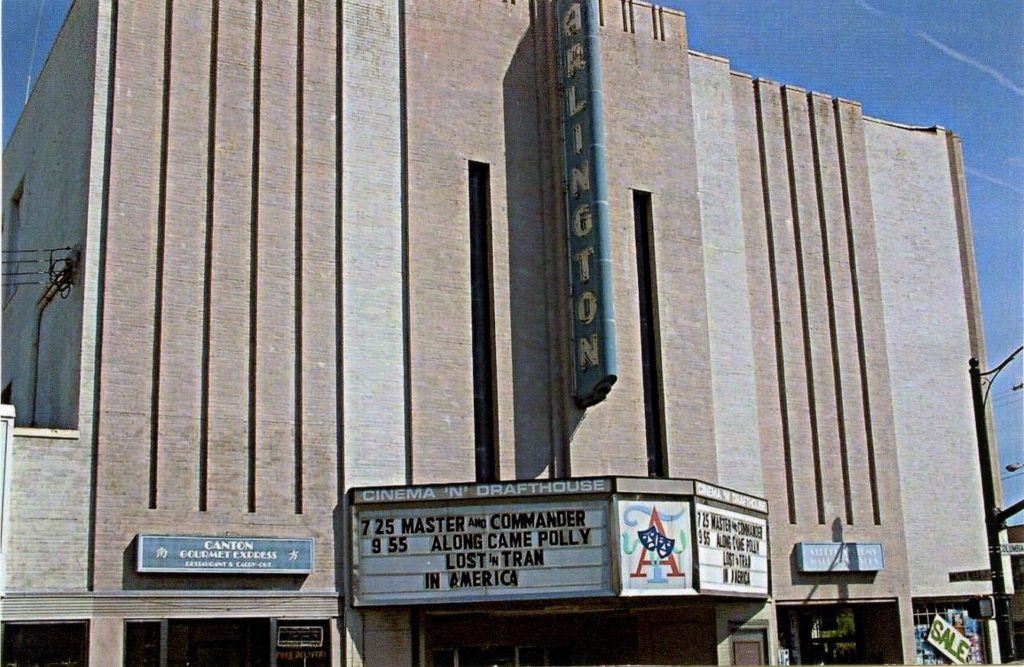Located at the intersection of Columbia Pike and South Fillmore Street, the Art Deco style building was a cinematic façade fit for its wide variety of movie screenings and could seat over 600 moviegoers at a time.
Part of a boom in cinema construction around the county, the Arlington Theatre joined the Wilson, Ashton, and Buckingham Theatres – all of which were part of the Neighborhood Theatres franchise. The Arlington Theatre was designed by architect Fred Bishop, who also designed Richmond’s iconic Byrd Theater and the Beacon Theatre in Hopewell.
The Arlington Theatre was a part of a larger building called the Arlington Recreation Center, which included commercial storefronts, a pharmacy, and a 24-lane bowling alley on the second and third floors. The bowling alley featured “modern, high speed” Brunswick Balke alleys and acoustical soundproofing. Bowlers could also treat themselves to the Center’s soda fountain and sandwich bar, or have orders delivered straight to their lanes.
The Arlington Theatre drew major media attention for its inaugural night. Its opening was covered in a special section of the August 16, 1940, edition of The Sun, where it was featured alongside pieces on the broader growth and development around the Columbia Pike area. A reporter described the theatre:
“Modern in every respect, housed in a fireproof building and equipped with the famous Carrier air conditioning system, which also cools and refreshes the bowling alleys and the pharmacy. Large, spring-bottom seat(s), amply spaced, assure comfort for theatre patrons, while the lobby, lounges, and restrooms are furnished and decorated in modern and attractive styles.”
The theatre’s first film showing was a 6:30 p.m. screening of the 1940 film “My Favorite Wife,” the “delightfully delirious comedy” (according to the theatre’s advertisement) starring Cary Grant and Irene Dunne. Part of the popular screwball comedy genre of the era and adapted from the Alfred Lord Tennyson poem, “Enoch Arden,” the film garnered a successful opening night, with one reviewer describing it as “fast-paced, delightful comedy entertainment.”
The film played for two additional showings during opening week, screening in full on Friday, August 16 and Saturday, August 17. All screenings were accompanied by a screening of the “Information Please” program, a radio quiz show in which audience members would ask experts questions. The panel show was so popular that RKO-Pathé Pictures released filmed versions of the radio program that were released as 10-minute-long clips to accompany feature film screenings. The “guest guesser” for this particular broadcast was the 1940 Republican presidential nominee Wendell Willkie.
The Arlington Theatre also became a popular location for numerous community events, and in 1940 hosted then First Lady Eleanor Roosevelt for a charity Christmas Party held by the Kiwanis Club. During World War II, the theater was a place to buy bonds and defense stamps to support the troops. The Arlington Theatre and the other Neighborhood Theatres in the area would host themed screenings, including designating September 1942 as “Salute to our Heroes” month, with ads for showtimes also including the call, “Come on, moviegoers! Buy war stamps here!”
In 1985, the building transitioned to its modern iteration as the Arlington Cinema ‘N’ Drafthouse, which still operates today. It stands as one of the last operational cinema buildings from the heyday of the 1930s and 1940s construction and includes the Arlington Theatre’s original theater behind its movie screen with lighting, storage, and a green room. The Cinema seats up to 275 guests and features both movie screenings and live entertainment.
Read The Sun’s coverage of the Arlington Theatre’s 1940 opening in the Community Archives.
Learn more about local cinema history in “Movie Theaters of Washington DC,” by Robert K. Headley, available at the Library.
To learn more about Arlington's history, visit the Center for Local History on the first floor of the Central Library.
Do you have a question about this story, or a personal experience to share?
Use this form to send a message to the Center for Local History.
Center For Local History - Blog Post Message Form
Do you have a question about this story, or a personal experience to share? Use this form to send a message to the Center for Local History.
"*" indicates required fields



